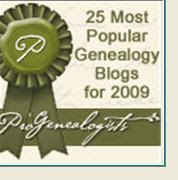 At the recent Jamboree, I spoke about our IberianAshkenaz DNA Project from the viewpoint of an administrator, presenting attendees with information on organizing such a project for their own interests, as well as setting goals, criteria, persuading people to test and other topics.
At the recent Jamboree, I spoke about our IberianAshkenaz DNA Project from the viewpoint of an administrator, presenting attendees with information on organizing such a project for their own interests, as well as setting goals, criteria, persuading people to test and other topics.On Sunday, as I waited in the Burbank Marriott lobby for the airport shuttle, I noticed a woman who had attended the session. Before we knew it, we were deep in conversation and missed two shuttles!
She began by saying that she had not intended to come to my IberianAshkenaz talk, but simply found herself there. I explained the meaning of the Hebrew word beshert, destiny or fate.
The San Diego resident shared that her grandmother wore a Jewish star, and so does she. When someone saw it and asked why, she said that it was because of her grandmother. The person said, "there's more to it than that."
Customs observed in her family included not eating pork, covering mirrors when someone died and other traditions. The family had no clue that the family was originally Jewish and thought the grandmother was Greek Orthodox. The family originally came from an area of Mexico I recognized immediately as a known Sephardic center.
The conversation was a moving experience for both of us. I gave her my card, told her about JGSLA 2010, July 11-16 in Los Angeles, which will have several sessions on Sephardim and Conversos, as well as the Sephardic Bnai Anousim conference, July 16-19, in El Paso, Texas.
The Hollywood (Florida) Sun-Sentinel offered a story a few days ago concerning the mysterious tug of Jewish heritage felt by some Hispanics. It includes quotes from Bennett Greenspan of FamilyTreeDNA.com and others.
Growing up in the Catholic faith, Trudi Berglin noticed her mother had a "compulsion" to buy a new set of dishes every spring. No one knew the origin of this family tradition — not even her mother.Many pretended to convert, athough continued secret observances and maintained contact with other similar families. Some traditions have survived until today, but the reasons why have been lost to many who still adhere to them out of respect for their elders.
Only after Berglin, 70, of Fort Lauderdale, became an adult did she learn about the Jewish custom of using a special set of dishes for Passover, which falls around Easter.
She also figured out her family fled from Spain to Italy at the time of the Spanish Inquisition in the 15th century. Under that royal Catholic tribunal for rooting out the unorthodox, Spanish Jews had three choices: leave, convert or die.
Tracing the Tribe was happy to see that the story mentioned the term conversos and also noted that another term - marrano - was pejorative.
The escaping Jews from Spain and Portugal went to Turkey, Holland and Bulgaria. They also settled in Brazil, France, Italy, Mexico and Peru. From around the world, many eventually came to America.
Now people like her are asking questions that spring from a lifetime of nagging feelings about their true background. Some are even turning to DNA testing to see if they have the markers that show they are, at the most basic genetic level, Jewish.A Catholic priest in Albuquerque NM - Rev. William Sanchez -was, as a child, warned away from eating pork and bacon.
"As an adult he took a test for the Jewish DNA marker, and it came back positive."That part of the newspaper article is not accurate. There is no Jewish DNA marker; there is a Cohen Modal Signature carried by those who today self-identify as Kohanim, or descendants of the High Priest Aaron, and share a specific marker signature. That is what Sanchez - and many other Hispanic men - carry. And many Jewish individuals are clustered in certain haplogroups.
Sanchez today runs the Sephardim-New Mexico Project (since 2002). It helps to identify of Jewish heritage in New Mexico. He estimates that 30% of the 210 men tested have Jewish ancestry.
But back to Berglin, mentioned in the story's first paragraph:
Purchasing new dishes at Pesach is a common Sephardic and Mizrahi custom. It was also observed by the Jews in Iran, when we lived there. Many families took the opportunity to purchase new sets of everyday china and pots and pans. Others kept Passover dishes separate from year to year as well as the large pots for rice. My late mother-in-law had all her huge copper pots re-tinned on the inside every year and used these for the week of Passover. Scholars have differing opinions as to how many Jews lived in Spain prior to 1492 and the Exile. Some estimate 100,000 of them decided to leave rather than convert, according to American Sephardi Federation's senior librarian and archivist Randall Belinfante.In Fort Lauderdale, Berglin became so convinced of her heritage that she converted to Judaism in 1989. Her mother's reaction: "Oh, I wondered if anybody
would ever go back.""I still get chills myself," Berglin said. "I said to her, 'Now I know why you bought all the damn dishes.' She said, 'Is that what they do?'
As far as tracing families back to Spain over the centuries is not so easy, but many families preserve certain Jewish customs and traditions.
"Now you are seeing the descendants of the descendants of the descendants keep some sort of tradition alive. So now, when we are free in the western world, they can creep out of the shadows and start asking questions," said Bennett Greenspan, the president of Family Tree DNA in Houston, which tests people for genetic markers.The story goes on to cover known conversos on Christopher Columbus's crew, and that among the settlers of Florida's oldest city, St. Augustine (founded 1565) are Jewish names.
He gets requests for Jewish testing from Hispanics "every single day ... from all over the country," Greenspan said. Although there is no "Jewish gene," there is a detectable pattern that can link an individual to a Jewish gene pool.
Clients tell him they "cannot rest" until they know the truth about their family's past.
There's also the story of native Peruvian Jeannina Torres, now living in Florida, and her hunch about her ancestry. Her Catholic family kept dishes separate for dairy and milk and she later learned that this was one of the tenets of kashrut. Both she and her sister have converted to Judaism. The family believes they went from Spain to Peru and that her mother's family name is Landa [TTT: Landa is also a known Eastern European Jewish name. Perhaps this is another candidate for our IberianAshkenaz DNA Project]. Her great-aunt mentioned, at the time of her sister's return to Judaism, that "somebody's going back to our roots."
Berglin is planning a visit to Northern Italy to interview older relatives, check records and also to visit Spain for more information.
Tracing the Tribe hears stories like these frequently. Those of us in a position to hear these stories must assist these individuals to learn more.
The map above, along with an excellent article on the Ladino language (in English and Ladino) may be seen at Lowands-Lnet.





































I love this artical. So many people criticize Hispanics being in their states, taking their jobs, not being legal.
ReplyDeleteWhile the ones complaining are just to lazy to work.
Be careful who you criticize, they just could be one of Gods chosen people! :)